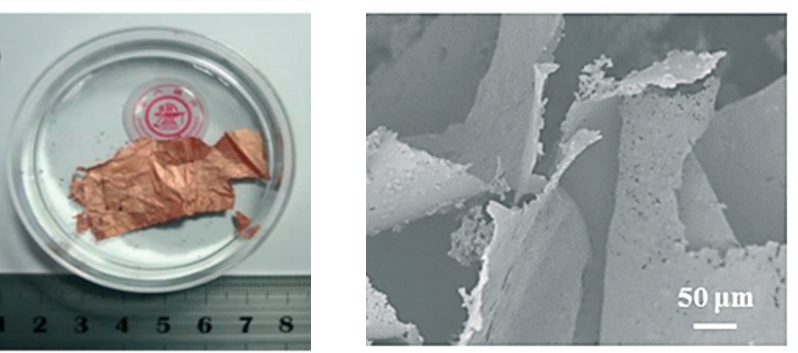The physical form of a compound affects its properties – one need only look at the explosion of research about nanosized materials in recent years to see the dramatic effects that size and shape can have on behaviour. Metal foams and foils with nanoporous structure have large surface-to-volume ratios, which make them valuable in a range of applications. Recently, Ming Li and colleagues, based in Shanghai, have developed a simple one-pot hydrothermal route to nanoporous copper foils that self-assemble in relatively short reaction times.
The mild hydrothermal route uses readily available starting materials, and ethylene glycol is employed as a reducing agent in the reaction. After 6 hours at 200°C the blue emulsion is transformed to a copper foil, which detaches itself from the Teflon wall of the autoclave liner.
The foil is thoroughly characterised and has a uniform thickness of approximately 1.4 microns, as seen in the SEM image below. A nanoporous structure can also be seen, accounted for by a mechanism of initial formation of Cu branches, which join together to form the foil as the reaction progresses. A thin coating of copper oxide on the surface makes the foils stable in air.
The as-synthesised copper foil and a close-up SEM image are shown below.
All so far so interesting, but what can such films be used for? The visible absorbance is higher than that of commercially available copper films owing to the nanostructure present. This means it can be used as an active substrate for surface enhanced Raman scattering (SERS). These substrates need to absorb light via surface plasmon resonance, an effect commonly seen in coinage metals. However, gold and silver have been found to be too expensive and too unstable, respectively, so cooper provides a high-performing low cost alternative.
Other potential applications include use as electrodes in batteries, solar cells or displays, and the authors hope that the method is applicable for the creation of other metal foils.
Find the full article here:
One-pot preparation of thin nanoporous copper foils with enhanced light absorption and SERS properties
Ming Li, Yanjie Su, Jiang Zhao, Huijuan Geng, Jing Zhang, Liling Zhang, Chao Yang and Yafei Zhang
CrystEngComm, 2015, 17, 1296-1304
DOI: 10.1039/C4CE01967A
 |
Rachel Coulter is currently working on a PhD at the University of Liverpool, investigating near-infrared absorbing materials. Her interests include solvothermal synthesis, optical applications of inorganic compounds and synthesis of nanoparticles. She received an MChem from the University of Edinburgh in 2011, which included an Erasmus year in Lille, France. |











